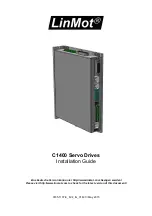
4.2 Motor Components
4.2.1 Shaft
The shaft transfers the motor force (torque) to the machine
coupled to the shaft.
The torque is transferred by a clamping set.
All servomotor types have a standardised shaft.
Shaft material: St60
ISD servomotors are sealed externally by a shaft seal. The
shaft seal is a consumable part (see
CAUTION
ISD 410 servomotors are not suitable for installation facing
upward with water "standing" on the shaft seal. Consult
Danfoss for specific applications.
130BC457.10
Illustration 4.6 Shaft
4.2.2 Brake (Optional)
The optional mechanical power-off brake is designed as a
single-disc brake with emergency stop function. The
emergency stop function can be initiated at most 20 times
per hour and 500 times in total.
The effective holding torque is 9 Nm.
The brake operates according to the fail-safe principle
"closed when no current". It is powered from the 300 V
DC link.
This enables zero-play load holding when no current is
present.
Electrical data: Current consumption 0.056 A at 205 V DC.
NOTE
The brake should not be misused as a working brake, as
this would cause increased wear, resulting in premature
failure.
4.2.3 Cooling
ISD servomotors are self-cooling.
Cooling (heat dispersal) is primarily via the flange, with a
small amount dispersed by the housing.
4.2.4 Winding/Motor
The winding causes the motor rotor to turn.
There is a choice of two winding and magnet packages.
They differ in speed and torque characteristics.
Winding protection: A thermal model is used to monitor
the maximum allowable power and switch off the motor if
it is exceeded. An error message is also sent over the CAN
bus to the higher-level master system.
4.2.5 Internal Components
Power/CAN bus loop input connector
DC link voltage (supply voltage) and CAN bus.
Power/CAN bus loop output connector
DC link voltage (supply voltage) and CAN bus for the next
servomotor.
Sensor I/O (port)
The sensor port includes digital input and output, an
analog input and the 24 V DC control voltage and
conforms to the PELV specification.
Output stage (IGBT)
The output stage converts the intermediate circuit voltage
to 3-phase AC voltage that drives the PM motor.
Controller (DSP)
Contains the processor that provides all control functions
for the ISD servomotor.
Resolver
The position controller of the ISD servomotor obtains its
data from a resolver. The analog signals from the resolver
are processed in the DSP and provided to the controller
with a 13 bit resolution.
The positioning accuracy of the servomotor is 0.25° in
relation to the motor shaft.
Other encoder systems are optionally available.
Description
VLT
®
ISD 410 Servomotor Operating Instructions
14
MG75D102 - VLT
®
is a registered Danfoss trademark
4
4
















































